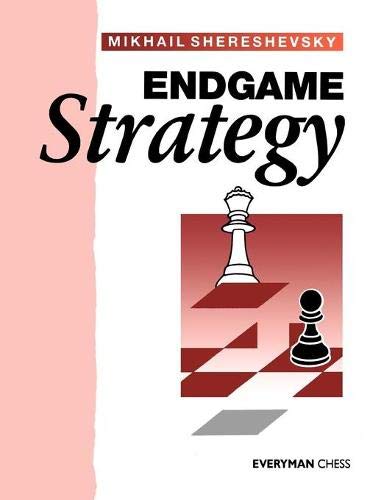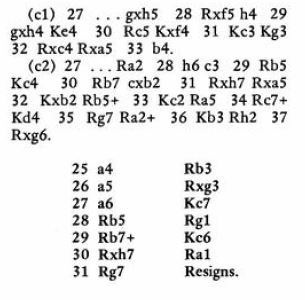Disclaimer 1: The following article contains several affiliate links to Amazon.com, meaning that if you go to Amazon and buy the recommended product (or some other product in an allotted period of time), the author of these lines will get a commission % from the purchase
Disclaimer 2: The following article is an excerpt from my article titled Best Chess Books 2022 in which I reviewed 20 chess books
Disclaimer 3: This book was previously reviewed on this blog by the former collaborator Bruno Pavčević. In this article, CM Vjekoslav Nemec expresses his – much less favourable – viewpoint.
Mikhail Shereshevsky: Endgame Strategy
Even though I have obviously heard about this famous endgame book and even though former collaborator on Chessentials Bruno Pavčević once reviewed it for this blog, it wasn’t until 2022 that I finally decided to actually check it out. Purely by coincidence, I did it at the beginning of the year, before the new and revised edition was published by New In Chess later in the year (and also on Chessable with the video presentation by GM Sam Shankland).
Endgame Strategy is a famous book devoted, well, to the strategy in the endgame. 1 In contrast to some other endgame books which cover different types of endgames in terms of pieces (Rook Endgames, Minor Piece Endgames, Queen Endgames, etc.), Endgame Strategy takes a slightly different route and approaches the endgame from the standpoint of endgame principles.
Over the course of 13 chapters, the author covers typical endgame principles such as the Centralization of the King, „Do Not Hurry” or The Principle Of Two Weaknesses. 2 Every chapter is supplemented with a series of examples (usually somewhere between 5-10, depending on the chapter) devoted to the topic at hand. The majority of examples are game fragments, although occasionally, the authors provide the readers with full games.
For the most part, the examples are really well-selected and highly instructive. The book is full of games by old champions such as Capablanca and Lasker and Soviet masters of the 1950s and 1960s, often featuring positions that might have as well arisen in one of our own games.There is definitely a tremendous value in setting these positions up, thinking about them, and playing through them while following the explanations.
With that being said, there were a few instances where the selection of examples caused me to raise an eyebrow. For example, take a look at the opening example of the 5th chapter of the book, devoted to the „Don’t Hurry” principle. I felt this is a very strange choice for the opening example of a very counterintuitive and difficult theme – not only because I think it is not the best demonstration of the „Don’t Hurry” principle – but also because the author’s analysis of this example is significantly flawed.
This brings me to the main problem with this book – the weakness of the game analysis. It is true that the mistakes in the analysis of the book originally published in 1981 are to be expected, but in my mind, in the Endgame Strategy, this reaches epic proportions. There are so many positions like the one given in the diagram above where the author totally misses the evaluation of the position.
I tried ignoring this aspect of the book as much as possible and simply play through the examples to get the feeling for these endgame positions. But in situations like this when the entire evaluation of the position was off the mark and when I had a zillion of questions even before I entered the position in Chessbase and turned on the silicon friend, I personally found them very bothersome.
Especially since I felt that the author of the book could have done a much better job when it comes to annotating the examples and stopping to explain some key points. Sure, at the beginning 3 of each example, a lengthy elaboration of the position on the board and how to apply the principle of interest is present, but once the moves start floating, I have found the commentary rather sparse. Very often in the book, there are long series of moves left without any text whatsoever. Maybe the most egregious example is featured on page 46 of the book:
I felt it would have been much more beneficial if the authors cut some examples earlier and used that space to add some more positions – or additional diagrams. Because the distribution and the number of diagrams in the book make it very difficult to read it without the use of the board.
In combination with the previously mentioned issues, this resulted in me basically entering every single example in Chessbase and clicking through it while simultaneously going through the text, which was – quite frankly – a tedious and frustrating experience, which kinda diminishes the point of reading a chess book, to begin with.
Thus, after going through the book I can’t avoid the feeling that it is one of those classic books that is nowadays somewhat outdated and quite overhyped. You might make an argument that 2200+ players are maybe not the target audience, but while I did find it quite superficial for my needs – I also feel it is quite complex and difficult for the players on the relatively lower end of the spectrum.
I honestly don’t know how many of these issues were corrected in the revised edition. But if I were to recommend a book on the topic of endgame strategy, I would probably recommend something like Understanding Chess Endgame by GM John Nunn 4 to lower-rated players or the renowned Mastering Endgame Strategy by GM Johan Hellsten to higher-rated players. I also think books such as 100 Endgames You Must Know and 100 Endgame Patterns You Must Know offer you a greater value for the buck while being immensely less frustrating and confusing to read. 5
- Quite shocking, I know
- Among others
- and often at the end
- A very underrated book, in my opinion, that has a fantastic outline as it explains principles in relation to specific endgames and which is also rich in explanations and has an abundance of diagrams.
- Even if some people find 100 Endgames You Must Know too vast, as mentioned earlier.



